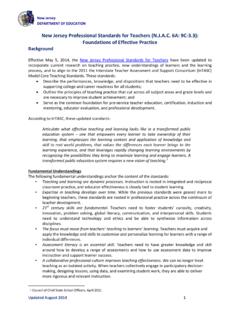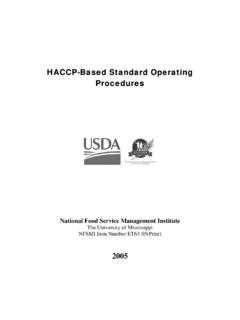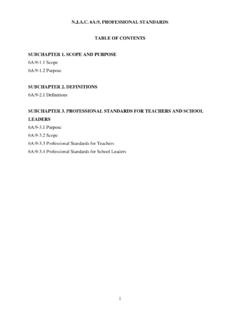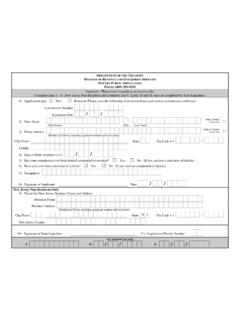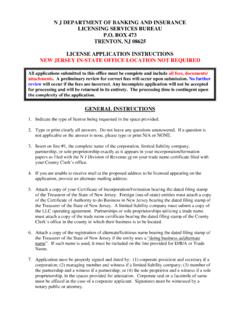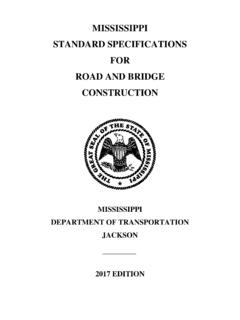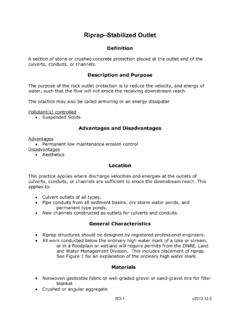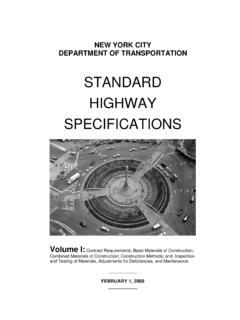Transcription of STANDARD FOR RIPRAP
1 standards for Soil Erosion and Sediment Control in New Jersey May 2012 22-1 STANDARD FOR RIPRAP Definition A layer of loose rock, aggregate, bagged concrete, gabions, or concrete revetment blocks placed over an erodible soil surface. Purpose The purpose of RIPRAP is to protect the soil surface from the erosive forces of water. Conditions Where Practice Applies This practice applies to soil-water interfaces where the soil conditions, water turbulence and velocity, expected vegetative cover, and groundwater conditions are such that the soil may erode under the design flow conditions. RIPRAP may be used, as appropriate, at such places as channel banks and/or bottoms, roadside ditches, drop structures and shorelines of open freshwater bodies. RIPRAP may also be used in conjunction with Soil Bioengineering Techniques which are found in that STANDARD (pg.)
2 26-1). This STANDARD applies to slopes less than ten percent. Water Quality Enhancement Both stream channel and shoreline environments will benefit from the protection against erosion caused by flowing water and wave action. Protection of banks and shores not only prevents soil loss directly into surface waters, but also protects vegetation in these areas which contribute other water quality and wildlife benefits.. Design Criteria - Open Channel Flow Conditions Design Storm The RIPRAP shall be designed to be stable when the channel is flowing at the design discharge or the 25-year frequency storm discharge, whichever is greater. Capacity shall be determined by the following methods: 1. Rational Method - for peak discharge of uniform drainage areas as outlined in Technical Manual for Land Use Regulation Program, Bureau of Inland and Coastal Regulations Stream Encroachment Permits, Trenton, September 1997 or subsequent editions 2.
3 USDA-NRCS hydrologic procedures such as WinTR55 or WinTR20. 3. Army Corps of Engineers HEC HMS 4. Other methods which produce similar results to the models listed above. RIPRAP Design Storm water conveyance or flood control channels RIPRAP shall be sized using the design procedures in this STANDARD or the "National Cooperative Highway Research standards for Soil Erosion and Sediment Control in New Jersey May 2012 22-2 Program Report No. 108, Tentative Design Procedure for RIPRAP -Lined Channels." These procedures are for determining a design stone size, such that the stone is stable under the design flow conditions. The design stone size is the d50 stone diameter. Erosive forces of flowing water are greater in bends than in straight channels. If the RIPRAP size (d50) computed for bends is less than 10% greater than the RIPRAP size (d50) for straight channels, then the RIPRAP size for straight channels shall be considered adequate for bends.
4 Otherwise, the larger RIPRAP size shall be used in the bend. The RIPRAP size to be used in a bend shall extend upstream from the point of curvature and downstream from the point of tangency a distance equal to five times the channel bottom width, and shall extend across the bottom and up both sides of the channel. RIPRAP for banks shall extend up the banks to the level of the design storm or the top of bank, whichever is lower. In channels where no RIPRAP or paving is required in the bottom, but is required on the banks, the toe of the bank RIPRAP shall extend below the channel bottom a distance at least 8 times the maximum stone size, but in no case more than 3 feet unless analysis of scour potential demonstrates the need for deeper installation. The only exemption to this would be if there is a non-erodible hard, rock bottom.
5 Stream stabilization- Soil Bioengineering For determining d50, RIPRAP may be sized using the procedures in this STANDARD or procedures contained in Chapter 16 of the NRCS Engineering Field Handbook including the Isbash Curve or Lane s Method. For stream stabilization, the use of RIPRAP is generally limited to critically erosive locations such as the base of the channel side slopes up to the elevation of the one year flow event. RIPRAP is designed to be used in combination with vegetation as a part of a bioengineering solution (see STANDARD for Soil Bioengineering). RIPRAP may be placed on slopes steeper than 2 horizontal to 1 vertical following the procedures in this STANDARD (Curve 22-6). Large, over-sized stone having a minimum d50 of 18 inches, or two times the required d50, whichever is greater, may be stacked to a slope no steeper than horizontal to 1 vertical where site conditions are acceptable.
6 Stability of the stream bank and bed material along with the flow conditions in the stream shall be evaluated in determining site acceptability. RIPRAP Gradation The RIPRAP shall be composed of a well-graded mixture such that 50% of the mixture by weight shall be larger than the d50 size as determined from the design procedure. A well-graded mixture as used herein is defined as a mixture composed primarily of the larger stone sizes, but with a sufficient mixture of other sizes to fill the progressively-smaller voids between the stones. The diameter of the largest stone size in such a mixture shall be times the d50 size. The d75 should be times the d50 and the d15 should be times the d50 size. The designer, after determining the RIPRAP size that will be stable under the flow condition, shall consider that size to be a minimum size and then, based on RIPRAP gradations actually available in the area, select the size or sizes that equal or exceed the minimum size.
7 The possibility of vandalism shall be considered by the designer in selecting a RIPRAP size. Thickness of RIPRAP Lining Construction techniques, discharge, size of channel, sizes and graduation of RIPRAP , etc., should be taken into consideration when determining the thickness of RIPRAP lining. The thickness of RIPRAP lining shall meet at least one of the following two criteria: 1. A thickness of at least three times the d50 size if a filter layer is not used. 2. A thickness of at least two times the d50 size if a filter layer is used. The minimum thickness shall be 6 inches. standards for Soil Erosion and Sediment Control in New Jersey May 2012 22-3 Filter Leaching is the process by which the finer base materials beneath the RIPRAP are picked up and carried away by the turbulence that penetrates the interstices of the RIPRAP .
8 Leaching is reduced to a negligible rate by using a properly designed filter under the RIPRAP , or by making the RIPRAP layer thick enough and with fine enough interstices to keep erosion currents away from underlying soil. A filter is required unless the RIPRAP lining has a thickness of at least 3 times the d50 size of the RIPRAP . On steep slopes, highly erodible soils, loose sand, or with high water velocities, a filter should be used or RIPRAP thickness increased beyond the minimums. A filter can be of two general forms. One is a geotextile manufactured for that express purpose. Another is a properly graded layer of sand, gravel, or stone. A sand, gravel, or stone filter shall meet the following criteria: d15 RIPRAP d15 RIPRAP < 5 < <40 d85 Filter d15 Filter d50 RIPRAP <40 d50 Filter Where d15, d50, and d85 are the diameters of RIPRAP and filter material of which 15, 50, and 85% are finer by weight.
9 The base material may be used as the filter if it meets the above criteria. The minimum sand gravel or stone filter thickness shall be 6 inches or 3 times the d50 size of the filter, whichever is greater. Geotextile fabric1 shall meet the following criteria: A. For filter fabric adjacent to granular materials containing 50% or less by weight of fines (Minus No. 200 material): For Woven Fabric: 1. 85% size of material (mm) >1 AOS2 (mm) and AOS no smaller than the opening in the STANDARD Sieve No. 100 1 Geotextile fabric shall meet the Army Corps of Engineers Guide Specifications, CW02215-86, for strength. RIPRAP that is 12" and larger shall not be dumped directly onto synthetic filter cloth unless the manufacturer recommends such use for the cloth.
10 Otherwise, a 4-inch minimum thickness blanket of gravel shall be placed over the filter cloth. Where seepage forces exist or where hydrostatic pressures may be developed in the base soil, the permeability of the geotextile shall be 10 times the permeability of the base soil. 2 Apparent Opening Size is defined as the number of the STANDARD sieve having openings closest in size to the geotextile openings. standards for Soil Erosion and Sediment Control in New Jersey May 2012 22-4 2. For non-woven fabric: AOS no larger than the opening in the STANDARD Sieve No. 40. B. For geotextile fabric adjacent to all other soils: For woven fabric: 1. AOS no larger than the opening in the STANDARD Sieve No. 70, and AOS no smaller than the opening in the STANDARD Sieve No.
